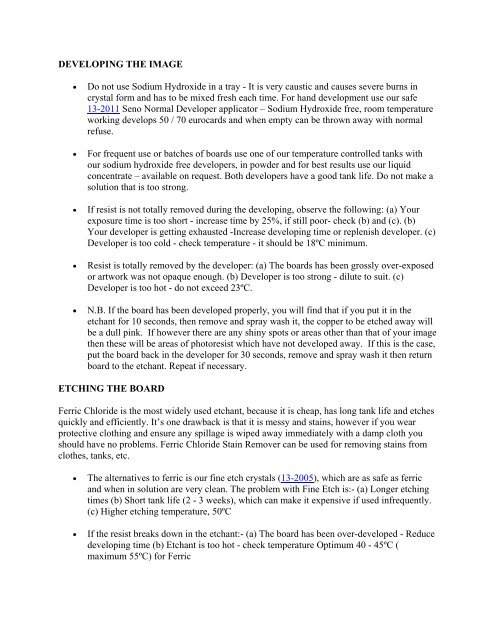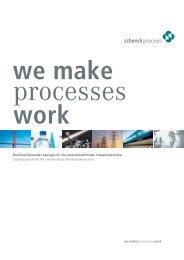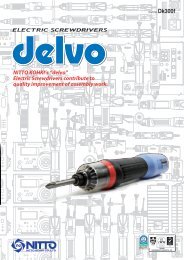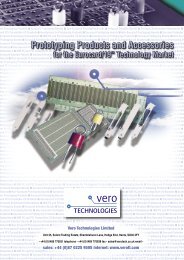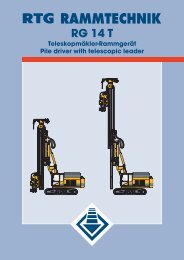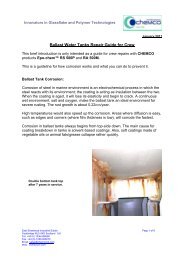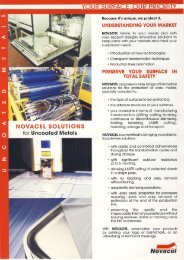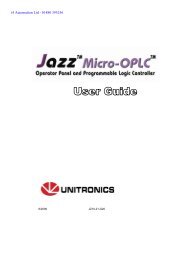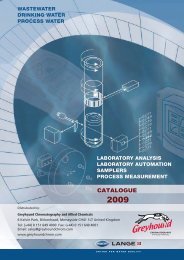SAFE AND ECONOMICAL STEPS TO PRODUCING A 'PCB'
SAFE AND ECONOMICAL STEPS TO PRODUCING A 'PCB'
SAFE AND ECONOMICAL STEPS TO PRODUCING A 'PCB'
You also want an ePaper? Increase the reach of your titles
YUMPU automatically turns print PDFs into web optimized ePapers that Google loves.
DEVELOPING THE IMAGE<br />
• Do not use Sodium Hydroxide in a tray - It is very caustic and causes severe burns in<br />
crystal form and has to be mixed fresh each time. For hand development use our safe<br />
13-2011 Seno Normal Developer applicator – Sodium Hydroxide free, room temperature<br />
working develops 50 / 70 eurocards and when empty can be thrown away with normal<br />
refuse.<br />
• For frequent use or batches of boards use one of our temperature controlled tanks with<br />
our sodium hydroxide free developers, in powder and for best results use our liquid<br />
concentrate – available on request. Both developers have a good tank life. Do not make a<br />
solution that is too strong.<br />
• If resist is not totally removed during the developing, observe the following: (a) Your<br />
exposure time is too short - increase time by 25%, if still poor- check (b) and (c). (b)<br />
Your developer is getting exhausted -Increase developing time or replenish developer. (c)<br />
Developer is too cold - check temperature - it should be 18ºC minimum.<br />
• Resist is totally removed by the developer: (a) The boards has been grossly over-exposed<br />
or artwork was not opaque enough. (b) Developer is too strong - dilute to suit. (c)<br />
Developer is too hot - do not exceed 23ºC.<br />
• N.B. If the board has been developed properly, you will find that if you put it in the<br />
etchant for 10 seconds, then remove and spray wash it, the copper to be etched away will<br />
be a dull pink. If however there are any shiny spots or areas other than that of your image<br />
then these will be areas of photoresist which have not developed away. If this is the case,<br />
put the board back in the developer for 30 seconds, remove and spray wash it then return<br />
board to the etchant. Repeat if necessary.<br />
ETCHING THE BOARD<br />
Ferric Chloride is the most widely used etchant, because it is cheap, has long tank life and etches<br />
quickly and efficiently. It’s one drawback is that it is messy and stains, however if you wear<br />
protective clothing and ensure any spillage is wiped away immediately with a damp cloth you<br />
should have no problems. Ferric Chloride Stain Remover can be used for removing stains from<br />
clothes, tanks, etc.<br />
• The alternatives to ferric is our fine etch crystals (13-2005), which are as safe as ferric<br />
and when in solution are very clean. The problem with Fine Etch is:- (a) Longer etching<br />
times (b) Short tank life (2 - 3 weeks), which can make it expensive if used infrequently.<br />
(c) Higher etching temperature, 50ºC<br />
• If the resist breaks down in the etchant:- (a) The board has been over-developed - Reduce<br />
developing time (b) Etchant is too hot - check temperature Optimum 40 - 45ºC (<br />
maximum 55ºC) for Ferric


